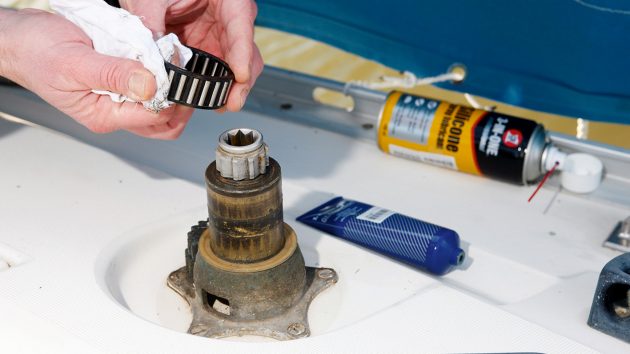Want to prepare your yacht for winter? Here's our short guide to to preparing your boat for the cold months ahead
Winter is a great time to make a detailed assessment of your boat’s condition. Dennis O’Neill offers some handy reminders on areas that shouldn’t be overlooked.
Standing rigging
Check sheaves, swages, split-pins, masthead lights and spreader mounts, looking out for any cracks, wear and tear or signs of corrosion, then sluice all moving parts (sheaves, furling drums, bottlescrews) with fresh water.
Running rigging
Inspect all running rigging for chafe, and wash halyards by filling your tender with fresh water to soak and then hand wash them with a generous squirt of liquid detergent.

Send tired sails to a professional sailmaker for quality repairs
Sails
Remove the sails to give them a thorough inspection, and, if necessary, send away for cleaning, or to a sailmaker for servicing and carrying out any repairs.
Navigation lights
Check that all the lights are working and look out for any water ingress. Remove bulbs to lubricate the terminals with a petroleum jelly, such as Vaseline.

This anode for this feathering prop is small, limiting its life but a shaft anode provides extra protection
Propulsion
Check your anodes, cutless bearing, rudder bearing and stern gland, and replace if necessary. Test steering cables and linkages for wear or slackness and adjust, or replace them, if required.
Moisture measures
Check the interior of your boat for any signs of damp or mildew, especially around the windows where leaks may occur. Dry bilges thoroughly and leave an absorbent pad, or even a couple of nappies, to soak up any condensation.
Plumbing
Drain pipes, pumps, water tanks and the calorifier to prevent freezing. Flush lots of water through the heads with a little washing-up liquid to lubricate. Empty the holding tank if you have one, then flush through with fresh water and tank cleaner. Check the heads pipes for calcification and replace if necessary.

Check your boat’s batteries
Batteries
Inspect the casing for bulges or cracks and the terminals for corrosion. Check voltage and fluid levels, and top up with distilled water and charge if required. Coat terminals with petroleum jelly.
Engine and fuel tank
Change engine oil and filter to prevent acidic waste deposits, then run the engine in both gears to evenly distribute the oil.Change gearbox oil, making a note of the date you do it. Spray engine with a good penetrating oil, such as WD40, and leave a cloth over the engine to minimise condensation. Fill the fuel tank to prevent condensation and add some bactericide to help eliminate biological and water contamination.

Check your safety items haven’t gone beyond their recommended service intervals and give your lifejackets a thorough once-over
Safety equipment
Check that all of your safety items, such as lifejackets, flares, personal location beacons and liferafts have not gone beyond their recommended service intervals. Test your gas and carbon monoxide alarms. Let out the anchor to rest on the ground and carefully check the condition of the links.
Enjoyed reading this?
A subscription to Yachting Monthly magazine costs around 40% less than the cover price.
Print and digital editions are available through Magazines Direct – where you can also find the latest deals.
YM is packed with information to help you get the most from your time on the water.
-
-
- Take your seamanship to the next level with tips, advice and skills from our experts
- Impartial in-depth reviews of the latest yachts and equipment
- Cruising guides to help you reach those dream destinations
-
Follow us on Facebook, Twitter and Instagram.





